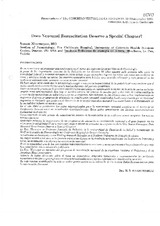Mostrar el registro sencillo del ítem
Does neonatal resuscitation deserve a special chapter?
| dc.contributor.author | Niermeyer, Susan | |
| dc.date.accessioned | 2017-05-03T18:22:34Z | |
| dc.date.available | 2017-05-03T18:22:34Z | |
| dc.date.issued | 2001-11 | |
| dc.identifier.uri | http://repositorio.umsa.bo/xmlui/handle/123456789/10340 | |
| dc.description.abstract | Neonatal resuscitation has developed into a distinct sub-discipline of pediatric resuscitation, which itself stands apart from adult cardiopulmonary resuscitation. What justifies this separate and special status? Does neonatal resuscitation, in fact, deserve a special chapter? This lecture will present the unique facets of physiology and pathophysiology in the newly born infant that necessitate an approach to resuscitation different from any other time in the lifespan. Using this physiology as a basis, the specific steps in neonatal resuscitation will be examined for their differences from the general pediatric recommendations. Changes in the International Guidelines for Neonatal Resuscitation published in 2000 will be presented in the context of the supporting evidence evaluation. Future directions for neonatal resuscitation will be examined with respect to the basic science of resuscitation, clinical applications, and the unique opportunities for prevention and prenatal intervention. The physiology of the newly born infant differs from that at any other point in the lifespan of a human being. The newly born infant must make a rapid transition from reliance on the placenta as the organ of respiration to use of the lungs for oxygenation and ventilation. Within a matter of seconds, the alveoli change from sacs distended with fluid to air-filled spaces where gas exchange occurs between the atmosphere and the blood. During fetal life, pulmonary blood flow represents only a small fraction of cardiac output, as much of the fetal venous return is shunted through the foramen ovale (from the right to the left heart) and ductus arteriosus (from the pulmonary artery to the aorta) [Figure 1]. Pulmonary blood flow rises dramatically after birth as the lungs expand physically with air. Both physical expansion of the lung and the vasodilatory effect of higher oxygen concentrations in the alveoli and the bloodstream contribute to a relaxation of pulmonary arteries and arterioles and a fall in pulmonary vascular resistance and pulmonary artery pressure. With lowering of right-sided pressures, the fetal shunts at the level of the foramen ovale and ductus arteriosus close functionally, and then anatomically. | es_ES |
| dc.language.iso | en | es_ES |
| dc.publisher | Segundo Congreso Virtual de Cardiología | es_ES |
| dc.subject | REANIMACIÓN NEONATAL | es_ES |
| dc.subject | NEONATOLOGÍA | es_ES |
| dc.title | Does neonatal resuscitation deserve a special chapter? | es_ES |
| dc.type | Article | es_ES |

